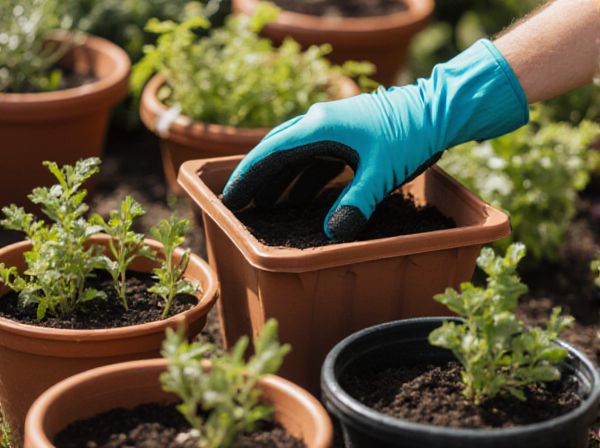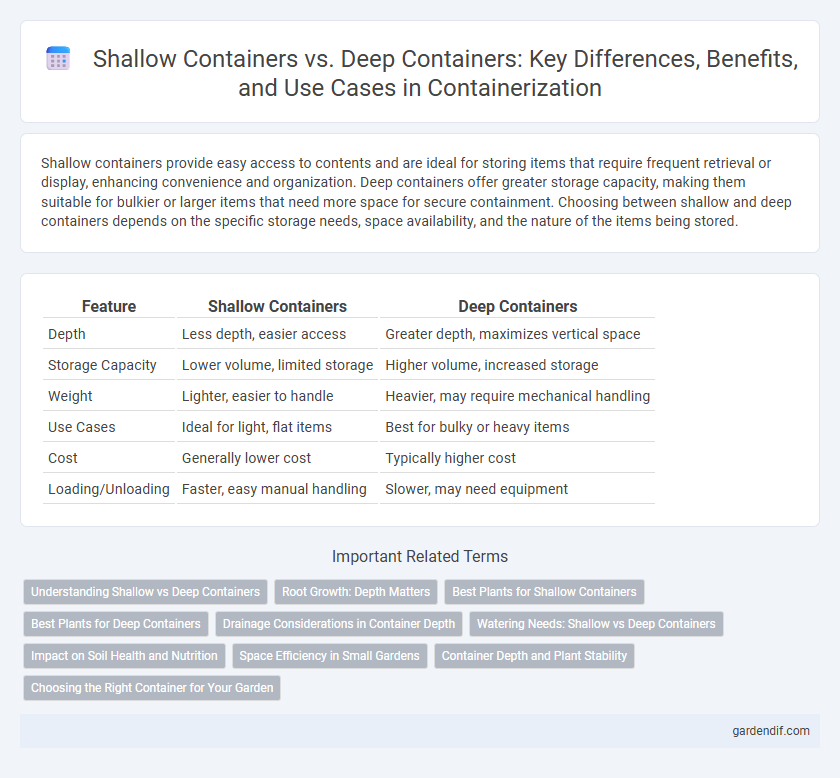
Shallow containers vs deep containers Illustration
Shallow containers provide easy access to contents and are ideal for storing items that require frequent retrieval or display, enhancing convenience and organization. Deep containers offer greater storage capacity, making them suitable for bulkier or larger items that need more space for secure containment. Choosing between shallow and deep containers depends on the specific storage needs, space availability, and the nature of the items being stored.
Table of Comparison
| Feature | Shallow Containers | Deep Containers |
|---|---|---|
| Depth | Less depth, easier access | Greater depth, maximizes vertical space |
| Storage Capacity | Lower volume, limited storage | Higher volume, increased storage |
| Weight | Lighter, easier to handle | Heavier, may require mechanical handling |
| Use Cases | Ideal for light, flat items | Best for bulky or heavy items |
| Cost | Generally lower cost | Typically higher cost |
| Loading/Unloading | Faster, easy manual handling | Slower, may need equipment |
Understanding Shallow vs Deep Containers
Shallow containers are designed for lightweight storage with limited depth, making them ideal for stacking and easy access in environments like shipping yards and warehouses. Deep containers offer increased storage capacity by maximizing vertical space, suitable for transporting larger volumes of goods while maintaining structural integrity. Understanding the trade-offs between shallow and deep containers helps optimize logistics efficiency, cargo protection, and handling requirements.
Root Growth: Depth Matters
Shallow containers restrict root depth, limiting access to nutrients and water, which can stunt plant growth and reduce overall health. Deep containers promote extensive root development, enabling plants to establish a stronger foundation and improve stability and nutrient uptake. Root growth in deep containers supports better moisture retention and aeration, essential for vigorous plant development.
Best Plants for Shallow Containers
Shallow containers are ideal for plants with shallow root systems such as herbs, succulents, and lettuce, which thrive in limited soil depth. These containers typically allow for faster drainage and are suitable for small-space gardening or decorative arrangements. Choosing plants like basil, thyme, or radishes ensures optimal growth and vibrant foliage in shallow containers.
Best Plants for Deep Containers
Deep containers provide ample root space for plants that require extensive growth and better moisture retention, making them ideal for vegetables like tomatoes, peppers, and root crops such as carrots and beets. These containers support large flowering plants, including hydrangeas and fuchsias, which thrive with deeper soil for nutrient access. Selecting deep containers enhances plant stability and growth potential by accommodating robust root systems for optimal health and yield.
Drainage Considerations in Container Depth
Shallow containers offer faster drainage due to reduced soil volume, minimizing water retention and lowering the risk of root rot, while deep containers retain more water, supporting moisture-loving plants but requiring careful monitoring to prevent waterlogging. Soil composition and container material also influence drainage effectiveness, with coarse, well-draining substrates enhancing runoff in both shallow and deep designs. Selecting the appropriate container depth depends on plant species' root systems and their water drainage needs to ensure optimal growth conditions.
Watering Needs: Shallow vs Deep Containers
Shallow containers require more frequent watering due to limited soil depth and faster moisture evaporation, making them ideal for plants with low to moderate water needs. Deep containers retain moisture longer, reducing watering frequency and supporting plants with extensive root systems that demand consistent hydration. Proper container depth directly influences watering schedules and plant health by balancing water retention and drainage.
Impact on Soil Health and Nutrition
Shallow containers limit root growth, restricting nutrient uptake and reducing soil microbial activity, which can lead to poorer soil health and lower plant nutrition. Deep containers provide ample space for root expansion, enhancing aeration, water retention, and nutrient availability while promoting beneficial soil microorganisms for healthier soil ecosystems. This difference directly influences plant vigor and yield by affecting the soil's physical structure and biological functions.
Space Efficiency in Small Gardens
Shallow containers maximize space efficiency in small gardens by allowing multiple units to be placed closely together, optimizing limited surface area without compromising plant health. Deep containers require more soil and space for root development, making them less ideal for compact garden setups. Selecting shallow containers enhances vertical gardening opportunities and improves substrate management for small outdoor spaces.
Container Depth and Plant Stability
Shallow containers provide limited root space, often resulting in reduced plant stability and increased susceptibility to toppling in windy conditions. Deep containers promote extensive root growth, enhancing anchorage and overall plant stability, especially for taller or top-heavy species. Optimizing container depth is crucial for balancing plant health and minimizing disturbance risks in both indoor and outdoor gardening.
Choosing the Right Container for Your Garden
Shallow containers are ideal for plants with shallow root systems like herbs, lettuce, and strawberries, promoting healthy growth by preventing waterlogging and root rot. Deep containers better accommodate root vegetables and larger plants, providing ample space for root expansion and nutrient absorption. Selecting the right container depth depends on the specific plant species, soil type, and drainage needs to ensure optimal garden productivity.
Shallow containers vs deep containers Infographic

 gardendif.com
gardendif.com